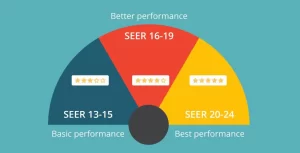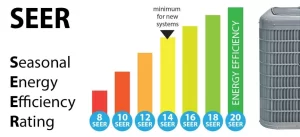SEER Ratings: What They Mean for Your HVAC System
Have you ever thought about what factors influence energy efficiency while choosing a new HVAC system for your home? The Seasonal Energy Efficiency Ratio (SEER Ratings) is an important factor to consider.
SEER ratings, developed by the United States Department of Energy, quantify the efficiency of air conditioners and heat pumps, alerting consumers about energy usage and operating costs.
If homeowners want to spend wisely on their home’s cooling efficiency system, they must understand SEER ratings.
In this article, we will discuss the importance of SEER ratings and their implications for improving the sustainability and efficacy of HVAC systems.
What is SEER Rating?
Another key indication used in the HVAC industry to assess air conditioning system effectiveness is SEER, or Seasonal Energy Effectiveness Ratio. The SEER rating of your heat pump or air conditioner is an efficiency metric that divides cooling output over a typical cooling season by Watt-Hours of energy consumed.
A system with a higher SEER rating is more energy efficient, which can lead to future energy bill savings. This statistic has a direct relationship with energy efficiency.
SEER ratings are important since they provide information about each unit’s efficiency. Recent regulations requiring HVAC equipment to have specific minimum SEER ratings have been put in place to help you save money and extend the life of your system.
Why do SEER Ratings Matter?
SEER ratings are extremely important because they provide consumers with crucial information about the energy efficiency of HVAC systems. These reasons include:
Energy Efficiency

An air conditioner or heat pump’s efficiency in converting energy into cooling is indicated by its SEER label. Elevated SEER scores suggest reduced long-term expenses related to energy usage, potentially leading to decreased power bills.
Cost Savings

Lower running expenses can be achieved by an HVAC system with a higher SEER rating because of its reduced energy usage. In the long run, this can have a big impact on energy bill reductions.
Environmental Impact
Purchasing a more energy-efficient air conditioner lowers your carbon footprint in addition to saving money and energy. By using safer refrigerants and using less electricity, these units help to preserve the environment for coming generations.
Upgrading to a newer, more energy-efficient model not only offers better comfort and cheaper operating expenses but also shows your dedication to sustainability.
Comfort and Performance
Higher SEER HVAC systems are more efficient and frequently offer more reliable and constant cooling, which improves overall comfort in both home and commercial buildings.
Long-Term Investment
Selecting a high-SEER HVAC system is a wise long-term financial decision. Even while there may be greater upfront expenditures, during the system’s lifespan, there may be possible energy savings and lower maintenance costs.
How Significant are SEER Ratings in Determining Energy Efficiency?
It is important to understand the SEER (Seasonal Energy Efficiency Ratio) rating of your air conditioner to make cost- and energy-effective decisions. U.S. Department of Energy requirements demand that newer models attain a minimum SEER rating of 13, whereas older units—typically constructed 10 to 15 years ago—typically have SEER ratings between eight and 10.
It is possible to save up to 20 to 40 percent on annual energy bills by upgrading from an older unit to one with a higher SEER rating (which ranges from 13 to 21 or higher). American Standard Heating and Cooling, for example, indicates their dedication to energy economy across a range of models by providing units with SEER ratings ranging from 14.5 to 22.
Beyond SEER rating, other significant considerations for a new HVAC system include insulation in your house and the state of your ductwork, both of which can affect overall efficiency.
Even units with SEER ratings of 13 or 14 can give significant savings over older ones, even though higher-rated units typically offer superior energy efficiency.
Understanding SEER vs. SEER2 Ratings
Regarding air conditioning systems, SEER (Seasonal Energy Efficiency Ratio) as well as its improved version called SEER2 is critical. These ratings do not only measure efficiency but also illustrate improvements in techniques that seek to offer real performances.
Exploring the details of SEER and more recently SEER2 is useful in understanding how the scores affect energy conservation, and the environment, as well as aiding the consumer to make better decisions.
SEER (Seasonal Energy Efficiency Ratio)

SEER serves as an important metric for evaluating the efficiency of air conditioners. It measures the cooling output of a unit over a typical cooling season, divided by the energy it consumes in watt-hours. This ratio provides consumers with a standardized way to gauge how efficiently an air conditioner operates under optimal conditions.
A higher SEER rating indicates greater energy efficiency, translating to potential cost savings on electricity bills and reduced environmental impact.
Challenges with SEER Testing Conditions
When it came to the effect of ductwork on system performance in residential settings, SEER testing methodologies were initially incomplete. Because of this error, during testing the external static pressure—a key factor impacting efficiency—was frequently underestimated. The layout and construction of ductwork in ducted systems usually result in higher exterior static pressures in real-world circumstances.
SEER2: Improved Testing Standards
Noticing the shortcomings of SEER, regulatory authorities came up with SEER2 with more stringent testing environments. The major difference is in increasing the minimum external static pressure during testing.
In doing so, SEER2 addresses actual residential conditions better because air conditioners function under higher pressures because of the ductwork. These updates intend to give consumers and regulators a better understanding of how well air conditioners operate under common residential conditions.
Benefits of SEER2 Implementation
The transition to SEER2 improves the credibility of efficiency ratings because it accounts for actual usage conditions. This improvement is beneficial for consumers to make the right decisions when purchasing air conditioning systems and also assists in other more energy-related goals. Thus, SEER2 promotes the use of more efficient technologies and thus reduces the overall consumption and greenhouse gas emissions.
Choosing the Right SEER Rating HVAC System for Your Home
Choosing the best HVAC system for your home is determined by several essential aspects, including achieving optimum efficiency at a reasonable cost. A higher SEER rating is always better because it reduces energy usage and consequently lowers utility expenditures.
Remember, that higher SEER comes at a higher initial cost for the system. When the weather is hot most of the year and the usage of an air conditioner is nearly unavoidable, it is financially prudent to install a unit with a SEER of 16 or higher.
However, if a region’s environment is chilly or air conditioning is rarely used, a lower SEER rating may be appropriate because it has little effect on the equipment’s overall performance or use.
The most appropriate SEER rating always fluctuates based on the climate in your area, how much you expect to use the system, how much you are willing to pay, and your long-term energy plan; hence, consulting HVAC professionals is recommended.
FAQs
Is a High SEER Rating Worth It?
For long-term energy savings, a high SEER (Seasonal Energy Efficiency Ratio) rating may be worthwhile. Despite higher initial expenses, it exhibits greater efficiency and may eventually result in lower utility bills. To evaluate whether the upfront investment is in line with your savings objectives, take into account your usage habits and climate.
How SEER Ratings Impact Your Energy Bills?
SEER ratings are directly relevant to energy bills as they indicate how efficiently electricity is used in an air conditioner. Higher SEER ratings equate to less energy usage and, as a result, cheaper monthly costs during the unit’s lifetime, even if the initial prices are higher.
